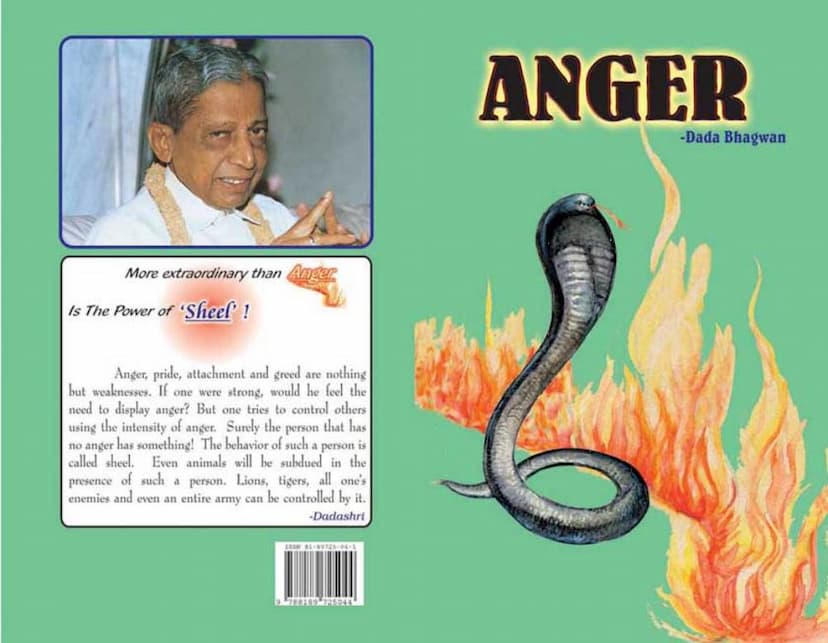Anger
Added to library: September 1, 2025

Summary
This Jain text, titled "Anger" and authored by Dada Bhagwan, published by the Dada Bhagwan Foundation, explores the nature of anger from a spiritual perspective, emphasizing its classification as a weakness rather than a strength. The core message is that true strength lies in inner character and self-control, often referred to as "sheel."
Here's a breakdown of the key themes and teachings presented in the text:
Anger as a Weakness:
- Contrast with Strength: The book directly contrasts anger with "sheel" (extraordinary moral character), highlighting that true strength doesn't require the display of anger. A person with "sheel" can subdue even wild animals and enemies.
- Root Cause in Weakness: Anger is identified as a weakness stemming from pride, attachment, and greed. Individuals resort to anger to control others when they lack inner strength.
- Lack of Control: Anger arises when one's desires are unmet, when others don't understand them, or when there are differing viewpoints. It often emerges when foresight or intuition is lacking.
- Self-Inflicted Harm: Anger is described as setting oneself on fire and then burning others. It's likened to setting one's own house ablaze, with internal destruction occurring first.
Understanding and Overcoming Anger:
- Karma and "Nimit": The text introduces the concept of "nimit" (instrumental causes), explaining that others who cause us anger are merely instruments delivering the results of our past karma. Understanding this helps detach from personal offense.
- Repentance and Forgiveness: When anger causes hurt, the text advises repentance, seeking forgiveness from the wronged person, and resolving not to repeat the behavior. This is crucial to avoid harboring grudges and future suffering.
- The "Knower": The core solution lies in recognizing the "knower" – the true Self – which is separate from the weaknesses of anger, ego, attachment, and greed. This knowledge allows for true liberation from these tendencies.
- "Pratikraman": The practice of "pratikraman" (divine apology) is presented as a key method for resolving anger. This involves acknowledging the mistake, repenting internally, and resolving not to repeat it. Asking for forgiveness from the Pure Soul within the other person is encouraged.
- Destroying Causes, Not Results: The emphasis is on eradicating the causes of anger (like seeing faults in others) rather than merely suppressing the results (the outward expression of anger).
- Ego as the Root: Anger is deeply rooted in ego. The text explains that recognizing the ego behind anger, and analyzing its connection to concepts like loss or the desire for one's own way, is essential.
- "Akram Vignan" (Step-less Science): The teachings are presented as part of "Akram Vignan," a direct and accelerated path to Self-Realization, which can be attained through the grace of a Gnani Purush (Enlightened One).
Nuances and Specific Examples:
- Anger with a Purpose: A nuanced perspective is offered on anger displayed by parents towards children or gurus towards disciples. If the intention is to improve the other person, and there's no selfish motive or intent to hurt, it can bind "punya" (merit karma). However, this is presented as a difficult path and a deviation from the ideal.
- "Sulking" as Anger: Sulking is identified as a form of persistent anger, highlighting the long-lasting impact of unresolved anger.
- "Gusso" vs. "Krodh": A distinction is made between annoyance ("gusso") and anger ("krodh"). "Krodh" is directly associated with ego, while "gusso" (like a father's annoyance with a child) can be less karmically binding if the intention is welfare.
- Internal vs. External Anger: The text discusses overt (sthool) and subtle (sookshma) karma related to anger. While outward actions have immediate consequences, the inner resolve ("bhaav") determines future karmic bondage.
- False Protectors: Anger and deceit are described as false protectors of pride and greed, ultimately perpetuating the weaknesses.
- Anger as Violence: Emotional reactions and anger are characterized as violence, destroying millions of "lives" (energetic entities within) and contradicting the practice of non-violence.
The Ideal State:
- Personality without Weakness: The ideal is to possess a personality free from the weakness of anger, which commands respect and attention.
- Calmness and Control: Maintaining calmness and a lack of anger leads to greater effectiveness and inner strength.
- True Knowledge: The ultimate solution lies in acquiring true knowledge, which eradicates weaknesses. This knowledge is attainable through the guidance of a Gnani Purush.
In essence, "Anger" by Dada Bhagwan presents a profound spiritual analysis of anger, urging readers to recognize it as a debilitating weakness and offering a path to its eradication through self-awareness, understanding karma, and ultimately, the realization of the true Self. The text emphasizes that true liberation comes not from suppressing anger, but from understanding its roots and transforming the inner being.